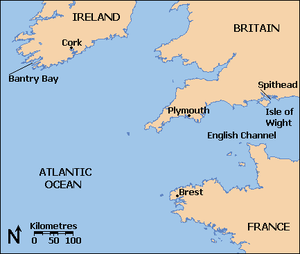Action of 21 October 1794
| Action of 21 October 1794 | |||||||
|---|---|---|---|---|---|---|---|
| Part of the French Revolutionary Wars | |||||||
|
Map of the region, the approximate location of the action marked in red |
|||||||
|
|||||||
| Belligerents | |||||||
|
|
|
||||||
| Commanders and leaders | |||||||
| Commodore Sir Edward Pellew | Captain Antoine René Thévenard | ||||||
| Strength | |||||||
| Frigates HMS Arethusa, HMS Artois, HMS Diamond and HMS Galatea | Frigate Révolutionnaire | ||||||
| Casualties and losses | |||||||
| 3 killed, 5 wounded | 8 killed, 5 wounded Révolutionnaire captured |
||||||
The Action of 21 October 1794 was a minor naval engagement between Great Britain and France fought off the Breton coast of France during the second year of the French Revolutionary Wars. French frigates had been raiding British Atlantic trade routes with considerable success since the outbreak of the war, and in response the Admiralty had formed a frigate squadron to patrol the French Channel and Atlantic coasts in search of French raiders. On 13 October 1794, the large, modern and powerful 40-gun French frigate Révolutionnaire under the command of Captain Antoine René Thévenard sailed from Le Havre for a raiding cruise against British trade routes in the Atlantic. Eight days later, while rounding the Breton headland of Ushant about 25–30 nautical miles (56 km) miles out to sea, Révolutionnaire encountered the British frigate squadron, commanded by Commodore Sir Edward Pellew, which had secured a number of victories over French raiding frigates during the previous two years.
Pellew ordered his ships to give chase, as Thévenard fled towards the French coast before the British numerical supremacy. One British ship was faster than the others, the 38-gun HMS Artois under Captain Edmund Nagle cutting Révolutionnaire off from the shore and bringing the larger French ship to action. For 45 minutes Artois battled Révolutionnaire until support arrived, at which point the French frigate's crew surrendered their ship in defiance of their captain's orders. Casualties and damage were light on both sides, and Révolutionnaire was rapidly commissioned into the Royal Navy, joining the squadron that had captured her and subsequently capturing the French frigate Unité at the Action of 13 April 1796.
Following the French Republic's declaration of war on Great Britain in February 1793, the French Navy immediately launched squadrons, individual cruisers and privateers against British trade routes in the Eastern Atlantic. The French Atlantic fleet, based at the fortified port of Brest in Brittany, was in a state of political turmoil during the early years of the war, suffering a mutiny in August 1793, and then defeat at the battle of Glorious First of June in 1794. In spite of these difficulties, the independent raiders caused considerable damage to British commerce, and in response the Admiralty ordered a squadron of frigates from the Channel Fleet to cruise the French coastline in search of these raiders. This force, known as the flying squadron and initially commanded by Sir John Borlase Warren, achieved a number of successes in the first year of the war, most notably in the Action of 23 April 1794, when a French frigate squadron was destroyed.
...
Wikipedia

